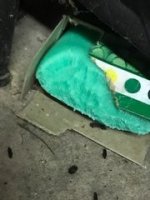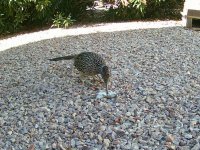The way I've stored anything with a battery and fuel is to us a battery tender, fill the tank with fuel, and add Stabilizer. A full charged, flooded cell or agm battery won't freeze until around -75f.
Some people inflate their tires to the pressure listed on the sidewall, and some go as far as placing the vehicle on stands to take the weight off the tires, but I've done neither, and have never had a problem. This goes for riding lawn mowers, motorcycles, and my 30,000lb Class A motorhome.
As for mice deterents, I'm sorry to say there is none. Lots of myths abound, I've heard them all, and unfortunately there's also good market for snake oil and miracle devices with their main aim being to lighten your wallet. Lights don't work, smells don't work, noise doesn't work. I was in pest control for over a decade, and if these things worked, they'd be SOP in the industry, and they would have made my job a whole lot easier. My van would have been full of cases of repellents, lights, and electronic pest chasers - alas, it was not. Believe it or not, there are people who study and test these ideas, and each year during our recert classes, someone would ask about these ideas, and the answer was always the same. "Nope, sorry they don't work." Oh, one study
did show about a 30% reduction in rat visits to an area sprayed with cat urine. Note: Even in that case, the rats were still visiting 70% of the time, so even that wasn't a good deterrent. Oh, and here's an oldie but goodie, Irish Spring soap was once commonly touted as a popular repellant. Guess what those marks are in the bar of soap? The droppings might offer a clue. Why? Well, while smelly, the main ingredient in soap is fat.

For context, I was responsible for facilities that had commercial kitchens, food storage buildings, lunchrooms, cafeterias, and offices used by just shy of 5000 people, and every single one of them ate there, and many had stashes of snacks in their desks and closets, so you can imagine the attraction to ants and rodents. Some of our buildings were so old and had been remodeled so many times, they were impossible to seal up. We also had a very healthy rat population at one facility, thanks to a creek that ran along the property that also passed a granary a block away where railroad cars of grain were dumped into grates under the tracks. This creek ran right behind our food storage warehouse and was a literal rat highway. You can imagine the challenge that posed in keeping those critters out of our food storage building. The only thing that worked 100%, was making sure that building was kept rat proof, and feeding them lots of bait from bait stations all around the outside. I like to tell people that they are dealing with pros that are working 24/7/365 at not only surviving but thriving in our world. In pest control I learned very quickly to NEVER underestimate the enemy, no matter how tiny. To do so, was to fail.
What do I do with my vehicles that are being stored? #1 is exclusion, which is the hardest step. Not everyone can store their vehicles in mouse proof buildings, myself included - my Spyder and car are in covered, but open storage, and the RV sits on the gravel alongside the house. So, I use bait stations, place traps, and make regular inspections. I like electronic Zap traps, but any trap will do. The key is
regular inspections. It called "monitoring" in the industry. Think of it like any other periodic maintenance you do. In my carport here in the desert, I check my traps daily, and bait stations weekly. If I find a dead mouse in the trap, I dump it outside for the local critters to snack on, refill, and reset the trap. I actually have a roadrunner that visits my yard daily and he/she makes the little bodies disappear. About once a week, I pop the hood of the car and check for nests, and do the same with the RV, although less frequently. Because I bait and trap, only once have I had a rodent try to make a nest on the engine of the car - it was a woodrat, commonly known as a packrat, and because I check weekly, I spotted the fresh nest under construction, removed it, and cleaned the area before the rat made the house a home. I eventually caught that beast in my zap trap in the carport, but until I did, he never returned to rebuild the nest in the car engine compartment. My most common catches are wood mice (field mice), an occasional Kangaroo rat, and woodrats (Packrats). Where I worked, the primary mouse catch was Deer mice. Oh, speaking of Deer mice - If you are ever cleaning up after mice, especially Deer mice, DON'T vacuum up the droppings, and be sure to wear gloves and even a mask because their feces and urine can contain Hantavirus which can become airborne when cleaning dry. While infection is rare, it's nasty when it happens. Do a search on the proper way to clean.
Some people don't like using bait for fear of secondary poisoning, which in reality for the homeowner, is very rare. However, an alternative is to deploy a mouse bucket trap. Do a search on how to make one. If you do use bait, make sure you buy two types with different active ingredients, and rotate them so that you reduce the chances of building a resistant population. This is more important for rats than mice, but it's good practice anyway.
You must make pest management a regular thing just like anything else you regularly do, because unless your vehicle is in a rodent proof building, it's subject to some little critter deciding it would make a nice home. One Spyder specific thing, that might make monitoring a little easier, is to remove one piece of tupperware while in storage, a piece that would allow you to look into the engine area - similar to how I pop the hood on the car.
Oh, and I'll wrap up my mouse control information with an explanation as to why lights, smells, and sounds don't work. The technical term is "Adaptation." We, as people, tend to make a common mistake when thinking about pests. We often think that they are passive, and when they encounter something that they don't like, they think: "Ew yuk!" Or "Danger!" and run away, never to return again. But wild critters trying to survive constantly evaluate their environment, not only for food, shelter, and breeding, but for hazards too. They are in a
constant state of learning. Adaptation is where they encounter something new, be it lights, sounds, or a new smell, and over a period of time, they learn that these things pose no threat. They adapt - a more common term would be that they get used to it, and the bad stimulus fades into the background. Remember, rodents are around wherever humans are. I dealt with mice in brightly lit boiler rooms, where loud equipment cycled off and on, and in smelly chemical storage rooms too. Rats use sewers to travel around cities, and sewers certain don't smell nice. You may remember the funny commercial on TV for Febreeze, where they asked the question: "Have you gone nose blind?" This is a real phenomenon, and it is an example of adaptation. It's a survival method used by the brain, where regular stimulus gets dialed down, pushed to the background of awareness, so any new stimulus can be detected. I lived in an area with small dairies, and a couple times a year the farmers would pump the "liquid" from their manure ponds into their fields for a couple weeks. Visitors would ask us how we could stand the smell, and a local would ask: "What smell?" That's because of adaptation. Personally, I prefer the term "Normalization." A bad sensory stimulus becomes normal over time. Oh, and don't be fooled by a gadget that claims randomly flashing lights prevent adaptation, because just the mere existence of flashing lights becomes normal in time.
Want a mouse Phun Phact? A mouse can fit through an opening just large enough to fit their skull through. They are then able to dislocate their shoulder and hip joints to squeeze their body through. We were shown an x-ray video of a mouse doing just that in one of our classes. It was amazing!
Ok. That's my professional, albiet now retired, input. I really wish I could share some sort of secret trick to keeping them away, I'd use it myself, and I'd shout it to the world.
Here's a photo from my trail camera of the local roadrunner, picking up the snack I tossed out for him that morning.



